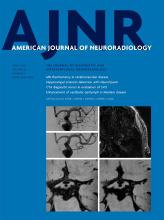Abstract
BACKGROUND AND PURPOSE: The massa intermedia is a normal midline transventricular thalamic connection. Massa intermedia aberrations are common in schizophrenia, Chiari II malformation, X-linked hydrocephalus, Cornelia de Lange syndrome, and diencephalic-mesencephalic junction dysplasia, among others. We have noticed that massa intermedia abnormalities often accompany other midline malformations. The massa intermedia has never been formally evaluated in a group of exclusively pediatric patients, to our knowledge. We sought to compare and contrast the prevalence, size, and location of the massa intermedia in pediatric patients with and without congenital midline brain abnormalities.
MATERIALS AND METHODS: Successive 3T brain MR imaging examinations from pediatric patients with and without midline malformations were procured from the imaging data base at a pediatric hospital. Massa intermedia presence, size, morphology, and position were determined using 3D-TIWI with 1-mm isotropic resolution. The brain commissures, septum pellucidum, hypothalamus, hippocampus, vermis, and brain stem were evaluated to determine whether alterations were related to or predictive of massa intermedia abnormalities.
RESULTS: The massa intermedia was more frequently absent, dysmorphic, and/or displaced in patients with additional midline abnormalities than in those without. The massa intermedia was absent in 40% of patients with midline malformations versus 12% of patients with normal findings (P < .001). Massa intermedia absence, surface area, and morphology were predictable by various attributes and alterations of the commissures, hippocampus, hypothalamus, vermis, brain stem, and third ventricle.
CONCLUSIONS: Most pediatric patients have a thalamic massa intermedia centered in the anterior/superior third ventricle. Massa intermedia abnormalities are commonly associated with other midline malformations. Normal-variant massa intermedia absence is a diagnosis of exclusion.
ABBREVIATION:
- MI
- massa intermedia
- © 2020 by American Journal of Neuroradiology












